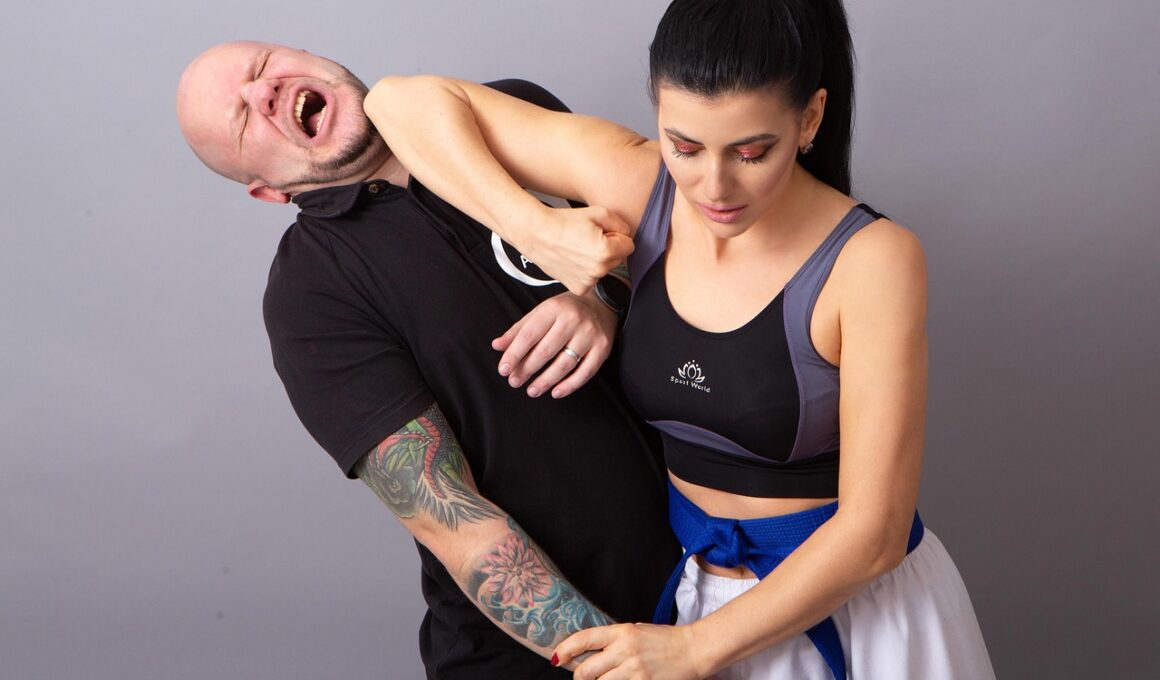Guided Breathing Sessions for Recovery After Self-Defense Exercises
Recovery after engaging in self-defense exercises is crucial for both mental and physical well-being. One effective method for recovery is to incorporate guided breathing techniques into your routine. These techniques not only facilitate relaxation but also help in lowering heart rates, allowing the body to transition back into a state of rest after intense physical activity. Practicing deep, intentional breaths encourages oxygen flow throughout the body, promoting healing and relaxation. The role of breathing is significant; it’s connected deeply to the body’s stress response. Engaging in structured breathing exercises can mitigate feelings of anxiety or adrenaline post-training. Studies have shows how regular breath work can optimize performance and overall health. Incorporating guided sessions within your self-defense practice establishes a holistic approach. You can find numerous resources online that offer structured breath work sessions tailored specifically for physical recovery. Whether you’re at a training facility or at home, these practices will greatly enhance your recovery process. Furthermore, regular practice will improve your focus and concentration in future self-defense scenarios, thereby enhancing your skill sets over time as you integrate breathing into your routine.
To effectively practice guided breathing after self-defense exercises, consider creating a dedicated space that is free of distractions. This environment should ideally be quiet and comfortable, encouraging a sense of peace. Begin by sitting comfortably or lying down, ensuring that your body feels supported. It is essential to close your eyes and focus your mind. The first step is to take a deep inhale through your nose, allowing your lungs to fill completely. This is followed by a slow exhale through your mouth, letting any tension escape your body. Make sure to count to four during the inhalation and to six while exhaling to develop better control over your breathing rhythm. As you practice, you may notice that you can gradually increase the length of each breath. Additionally, consider incorporating visualization techniques into your breathing sessions. Picture a calm scene, like a gentle wave or a serene landscape, as you breathe in. This can amplify relaxation and mental clarity while easing stress accumulated during the exercises. Bringing this mindful approach to your post-training recovery will significantly enhance your self-defense practice and overall wellbeing.
The Benefits of Guided Breathing
Guided breathing sessions have specific advantages that can enhance recovery after physically demanding self-defense training. Firstly, these sessions can significantly reduce feelings of anxiety and stress due to their calming effects on the nervous system. Reduced stress levels mean lower cortisol production, which is beneficial for both mental and physical health. Secondly, conscious breathing promotes blood circulation within the body, ensuring that muscles receive necessary nutrients and oxygen to recover efficiently. This support is crucial for muscle repair and can help alleviate post-exercise soreness. Lastly, engaging in structured breath work can block out distracting thoughts, helping to clear your mind and focus on the here and now. Mindfulness is essential in self-defense scenarios; improved mental clarity can boost your ability to react during training or actual situations. To maximize the benefits of guided breathing, consider incorporating it into your weekly training schedule. This consistency will allow you to reap all the mental and physical advantages of these practices over time. So, whether you prefer to follow along with a guided audio process or simply rely on your rhythm, integrating breathing sessions into your recovery is a smart move.
When structuring your sessions, consider varying your breathing techniques to suit your daily needs. For example, box breathing is a popular technique that involves inhaling for a count of four, holding for four, exhaling for four, and then pausing for another four counts. This method teaches you to maintain steady breath patterns, which can be particularly useful after intense training. Alternatively, the 4-7-8 method encourages longer breaths, thus promoting deeper relaxation. In this approach, inhale for four seconds, hold your breath for seven seconds, and exhale for eight seconds. This method directly engages the parasympathetic nervous system, effectively promoting relaxation. Combine these techniques with gentle stretching to further enhance your recovery. As you stretch, breathe deeply to release tension in your muscles. This synergy of breath work and movement helps create a beautiful flow of energy through your body. Additionally, you may find that recording your breathing sessions offers a way to track your progress and refine your techniques. Experiment with different approaches and notice how they impact your recovery following self-defense exercises for the best personal results.
Integrating Breathing Techniques into Self-Defense Training
Integrating breathing techniques into regular self-defense training offers numerous benefits. As you sharpen your physical skills, pairing them with breath work can significantly increase your mental acuity and overall performance. This holistic approach allows you to cultivate a deeper awareness of both your body and mind during each session. It’s imperative to understand the interconnection between breath and movement in self-defense. Practicing breath control while executing techniques enhances focus; when you breathe properly, you engage core muscles effectively. Furthermore, during practice, you may encounter moments of stress or adrenaline spikes. Utilizing guided breathing can help you regain composure and execute more effective moves. Coach your body to respond more fluidly by marrying these skills each time you train. Consider incorporating brief breathing exercises between rounds or during breaks to maintain clarity. Every time you finish a sequence, take a moment for a few deep breaths to reset your focus. Over time, this practice can enhance your performance in high-pressure scenarios, ensuring your response remains sharp when it’s most needed in real-world situations. Remember, awareness is fundamental in self-defense, and breath plays an essential role in this discovery.
To ensure the most effective recovery following your sessions, reflect on how your breathing affects your overall practice. Gathering insights can lead to improved techniques over time, maximizing stamina and focus. After each self-defense session, consider journaling your experiences with linked breath work. This practice allows you to determine which techniques yield the quickest recovery, maintaining high performance in future trainings. You may find that certain breathing patterns suit your style better than others; adapting these practices will personalize your recovery approach beautifully. Additionally, share these thoughts with training partners or instructors who can provide additional insights. Peer feedback can expose you to varying techniques or perspectives. By engaging in discussions over methodologies, you will have the opportunity to explore new avenues of recovery through breath work. As you discover what complements your physical practice best, the synergy created between breath and movement becomes profound. Ultimately, both recovery and skill development through deliberate breath will contribute to your readiness, ensuring every training is more beneficial. Cultivating this awareness will not only enhance your abilities but also serve you well in future self-defense situations.
Finding Resources for Guided Breathing
Finding resources to practice guided breathing is easier than ever, thanks to the proliferation of online content. Numerous platforms offer access to videos, audio files, and apps aimed at well-structured breath work. Just a quick search online can yield a wealth of information tailored to various proficiency levels and goals. Websites dedicated to self-defense training often have curated resources specifically designed with recovery breathing techniques in mind. Alternatively, consider exploring meditation and mindfulness resources that focus solely on breathing. Apps like Calm or Headspace offer guided sessions that can seamlessly integrate into your post-training routine. Additionally, joining local or online workshops can enhance your understanding of breathing techniques in depth, supported by expert instruction. Look for classes led by professionals who specialize in physical fitness or stress management. This collaboration can help you gain personalized insights while fostering community engagement. Social media platforms frequently feature inspirational content as well, providing motivation to maintain your breath work practice. Consistently exploring these resources can create a supportive atmosphere for your self-defense practice, enabling effective recovery and overall improvement.
Finally, remember that consistency is key when incorporating guided breathing techniques into your recovery after self-defense exercises. Regular practice not only reinforces learned skills but also builds a strong foundation for performance under pressure during actual situations. Allocate specific times within your weekly training schedule dedicated solely to breath work to effectively solidify these techniques into your routine. Gradually beginning with just a few minutes of mindful breathing can lead to significant improvements over time. Aim to maintain a balance; while physical skills are vital, mental acuity is equally critical. By consciously dedicating time and energy to these sessions, you create a deeper connection between your mind and body during every training. The outcome will significantly elevate your capabilities in self-defense scenarios, resulting in better performance and higher confidence levels. As you cultivate the synergy between breathing and movement, your approach to self-defense becomes more holistic and effective. Ultimately, guided breathing offers an essential tool to enhance recovery, enable focused training sessions, and promote a resilient mindset. By embracing these practices, you not only enrich your self-defense skills but also improve overall wellness.


